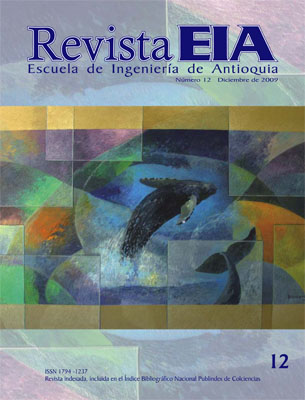INFLUENCIA DE LA VEGETACIÓN EN LOS NIVELES DE RUIDO URBANO (INFLUENCE OF VEGETATION IN URBAN NOISE LEVELS)
INFLUENCIA DE LA VEGETACIÓN EN LOS NIVELES DE RUIDO URBANO (INFLUENCE OF VEGETATION IN URBAN NOISE LEVELS)


This work is licensed under a Creative Commons Attribution-NonCommercial-NoDerivatives 4.0 International License.
Copyright statement
The authors exclusively assign to the Universidad EIA, with the power to assign to third parties, all the exploitation rights that derive from the works that are accepted for publication in the Revista EIA, as well as in any product derived from it and, in in particular, those of reproduction, distribution, public communication (including interactive making available) and transformation (including adaptation, modification and, where appropriate, translation), for all types of exploitation (by way of example and not limitation : in paper, electronic, online, computer or audiovisual format, as well as in any other format, even for promotional or advertising purposes and / or for the production of derivative products), for a worldwide territorial scope and for the entire duration of the rights provided for in the current published text of the Intellectual Property Law. This assignment will be made by the authors without the right to any type of remuneration or compensation.
Consequently, the author may not publish or disseminate the works that are selected for publication in the Revista EIA, neither totally nor partially, nor authorize their publication to third parties, without the prior express authorization, requested and granted in writing, from the Univeridad EIA.
Show authors biography
El objetivo del estudio fue evaluar la capacidad de la vegetación para mitigar el ruido en el valle de Aburrá. La metodología comprendió dos fases: la primera consistió en la revisión de información secundaria relacionada con dicha función de la vegetación, lo que permitió obtener las bases conceptuales para el posterior desarrollo experimental. En la segunda fase se realizó la medición de los niveles de ruido a 10 m de la fuente sonora (vía de alto tráfico vehicular) en zonas verdes públicas urbanas con diferentes coberturas vegetales (arbórea, arbustiva y arbórea-arbustiva) y sin vegetación. Los resultados no arrojaron diferencias significativas entres los sitios con vegetación y sin ella, lo que permite inferir que en las condiciones del estudio, caracterizadas por contar con unos pocos individuos arbóreos o arbustivos dispersos y poco densos, la vegetación no cumple un papel significativo en la disminución del ruido. Por lo tanto, para su control en zonas urbanas deben tomarse medidas diferentes a la plantación de árboles, o establecer barreras vivas más anchas, largas, altas y densas.
Abstract: The objective of the study was to assess the capacity of vegetation to reduce the noise in the Aburrá valley. The methodology comprised two phases: the first was the revision of secondary information related to the role of vegetation and to obtain the conceptual bases for further experimental development. The second phase was the measurement of noise levels 10 m from the sound source (high traffic road) in urban public green zones with different plant coverage (tree, shrub, and a mixture of trees and shrubs) and without vegetation. Results showed no significant differences between the sites with and without vegetation, allowing us to infer that under conditions of the study, characterized by having few individuals of trees and shrubs dispersed, the vegetation does not play a significant role in reducing noise. Therefore, for its control in urban areas measures other than the planting of trees must be taken, or wider, longer, denser, and higher live barriers should be established.
Article visits 508 | PDF visits 374
